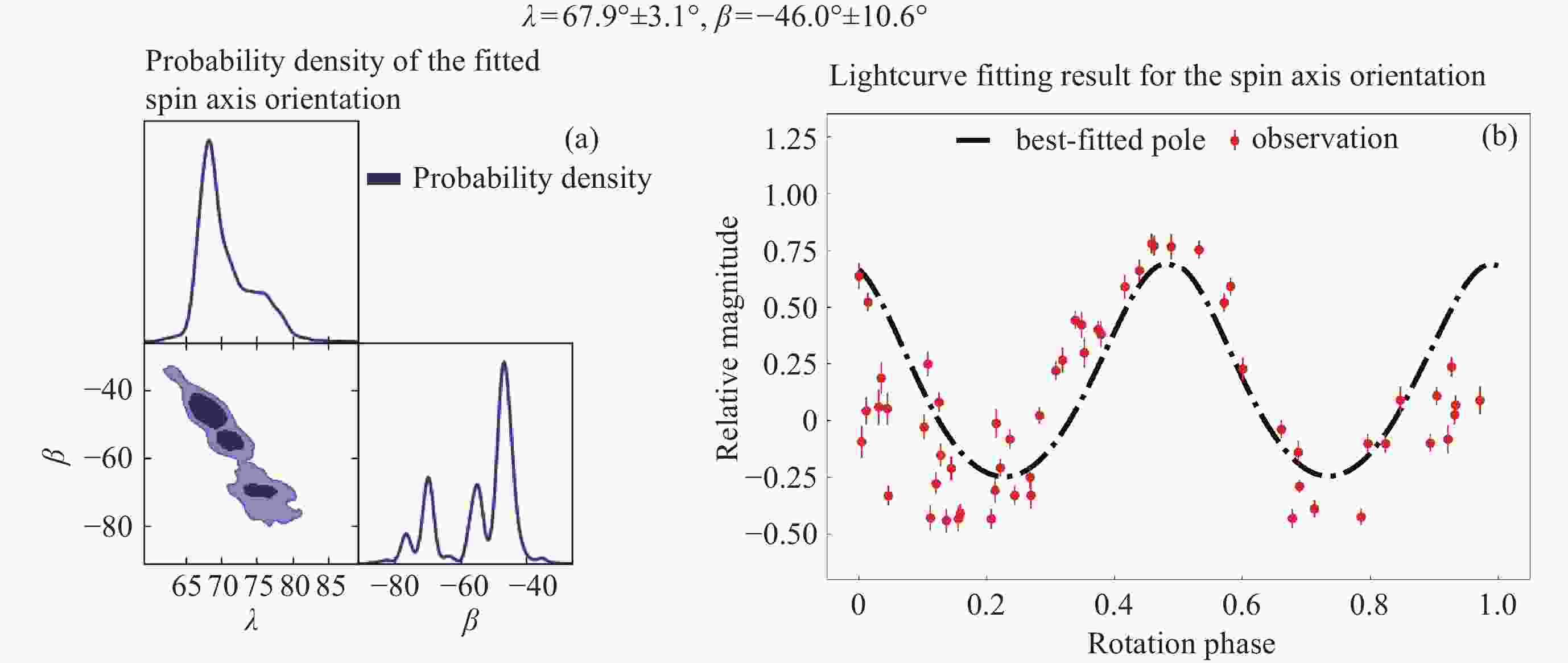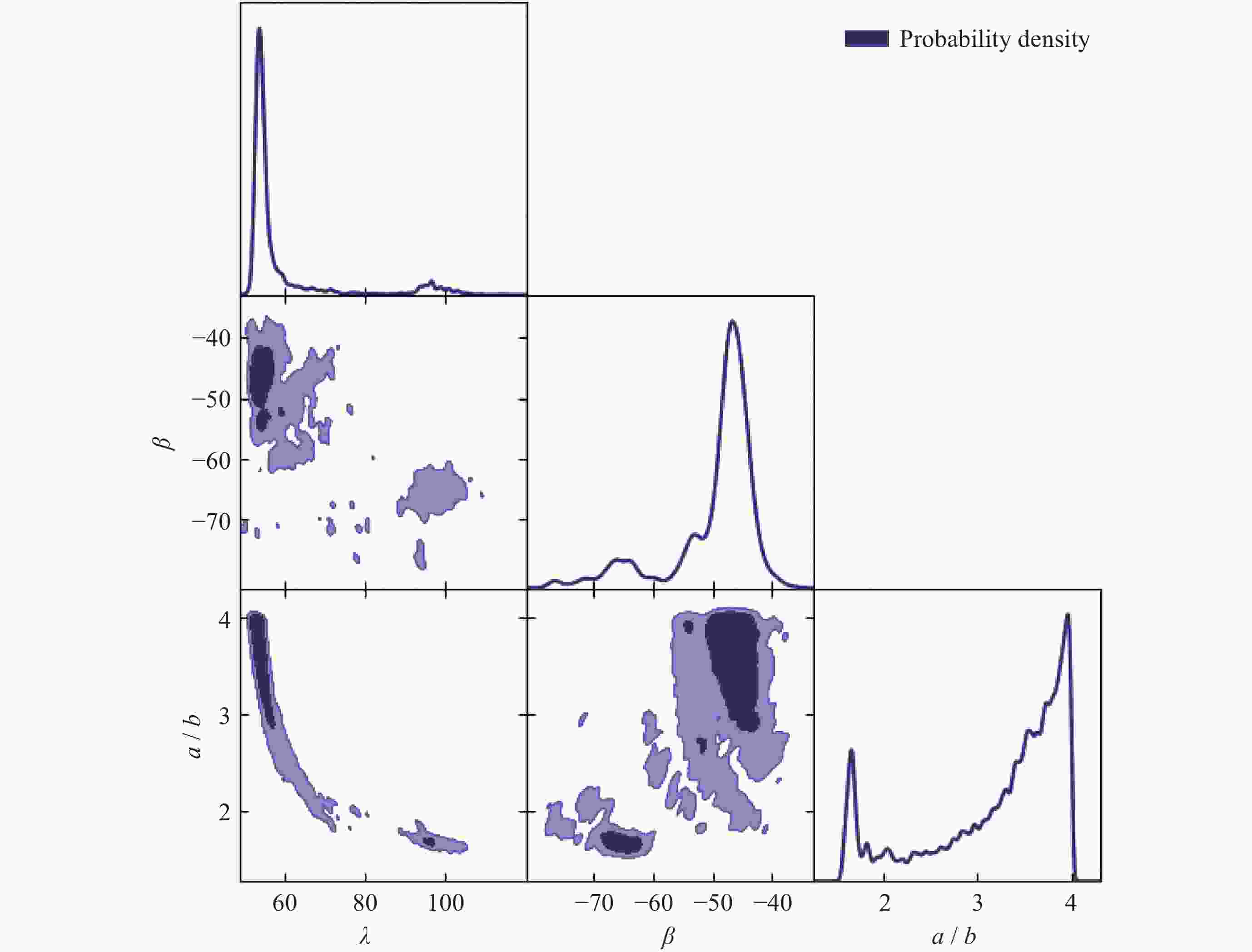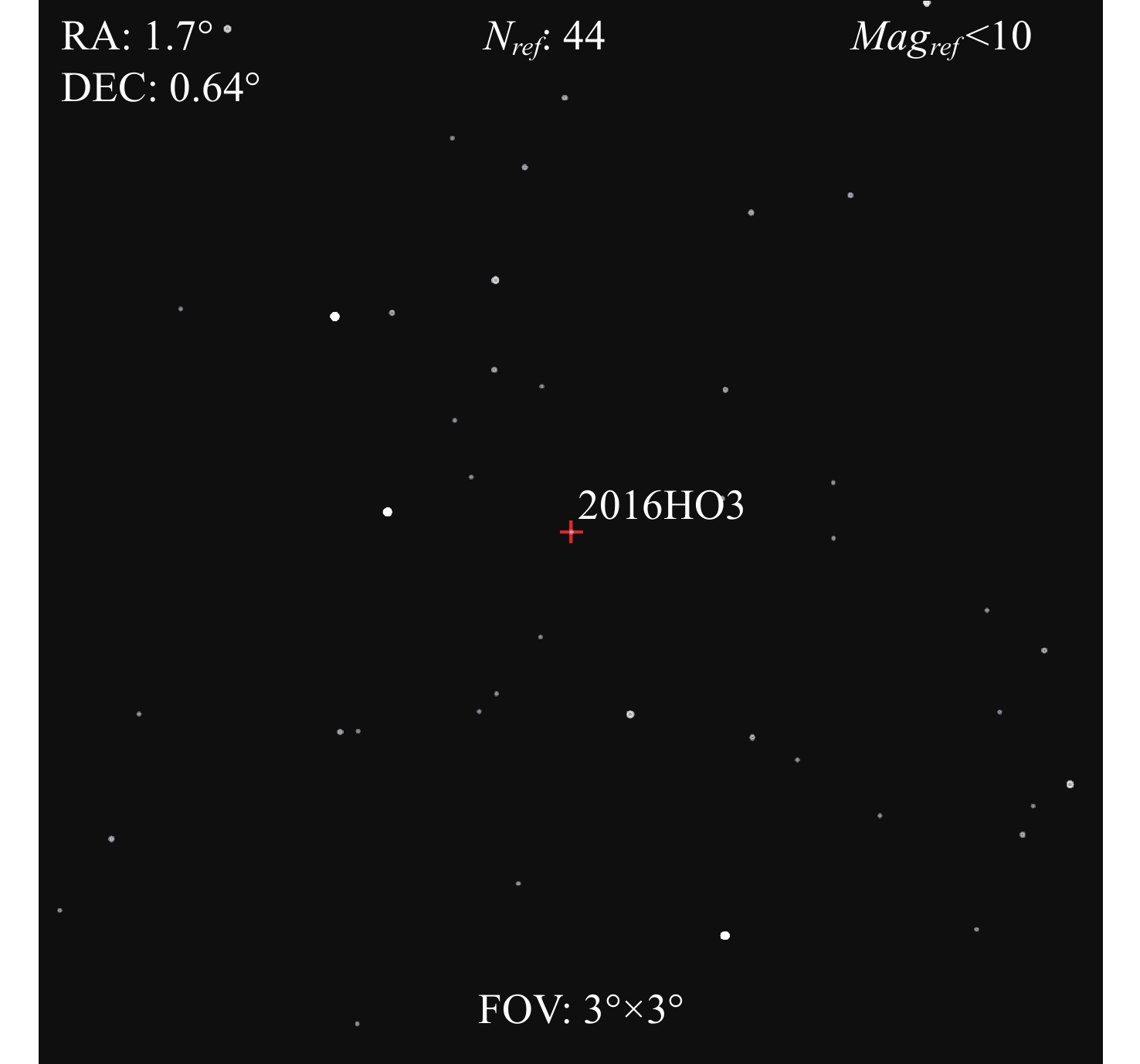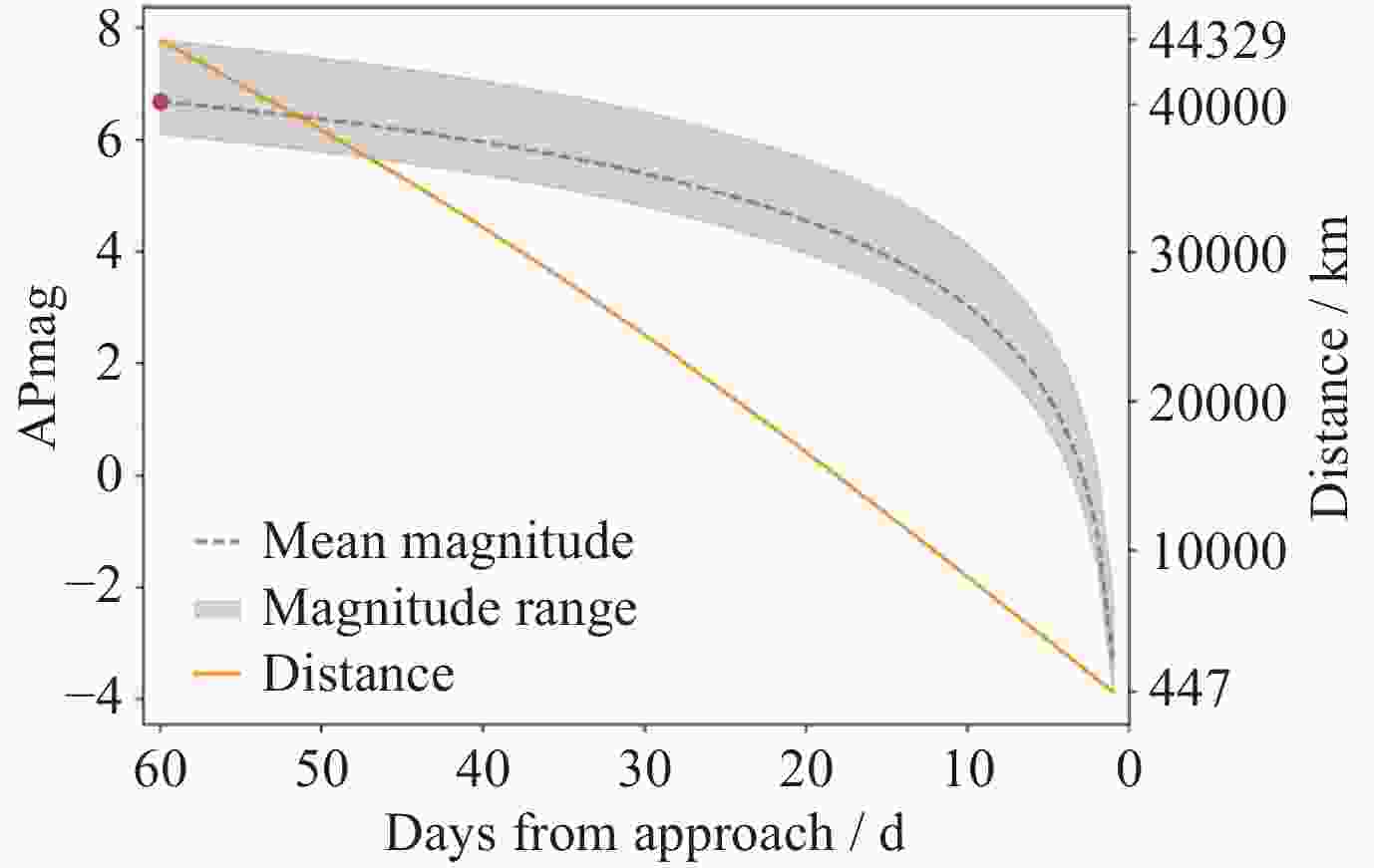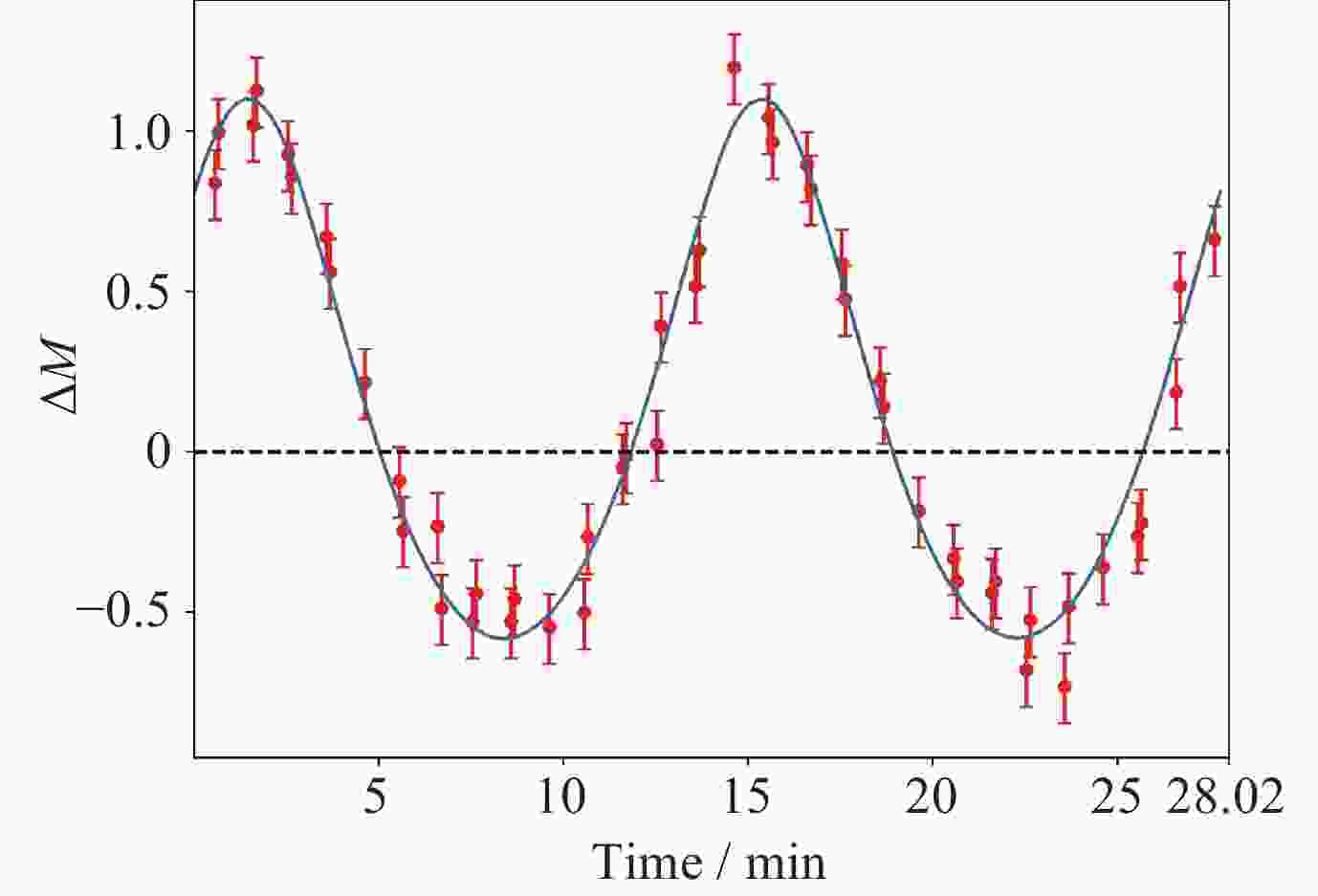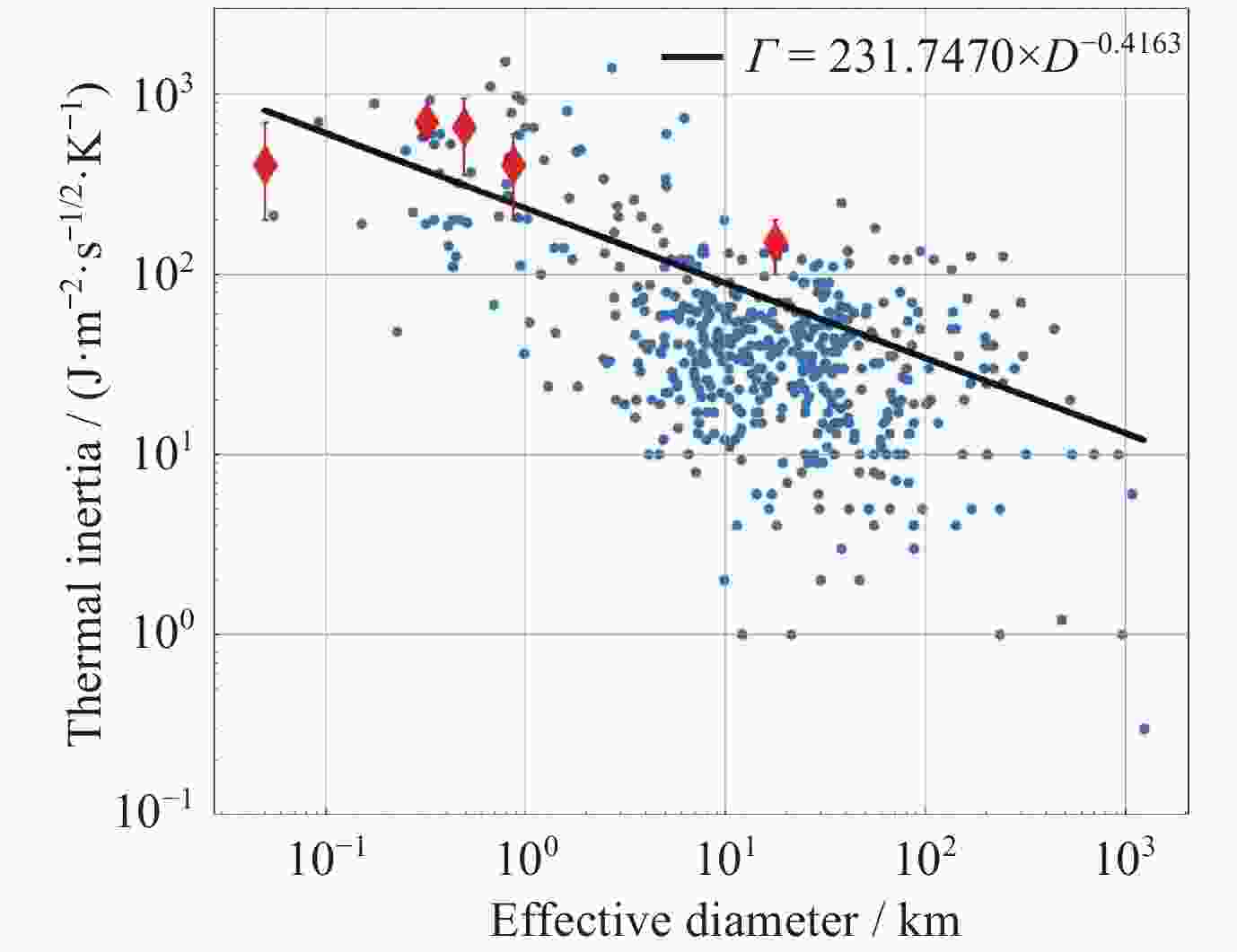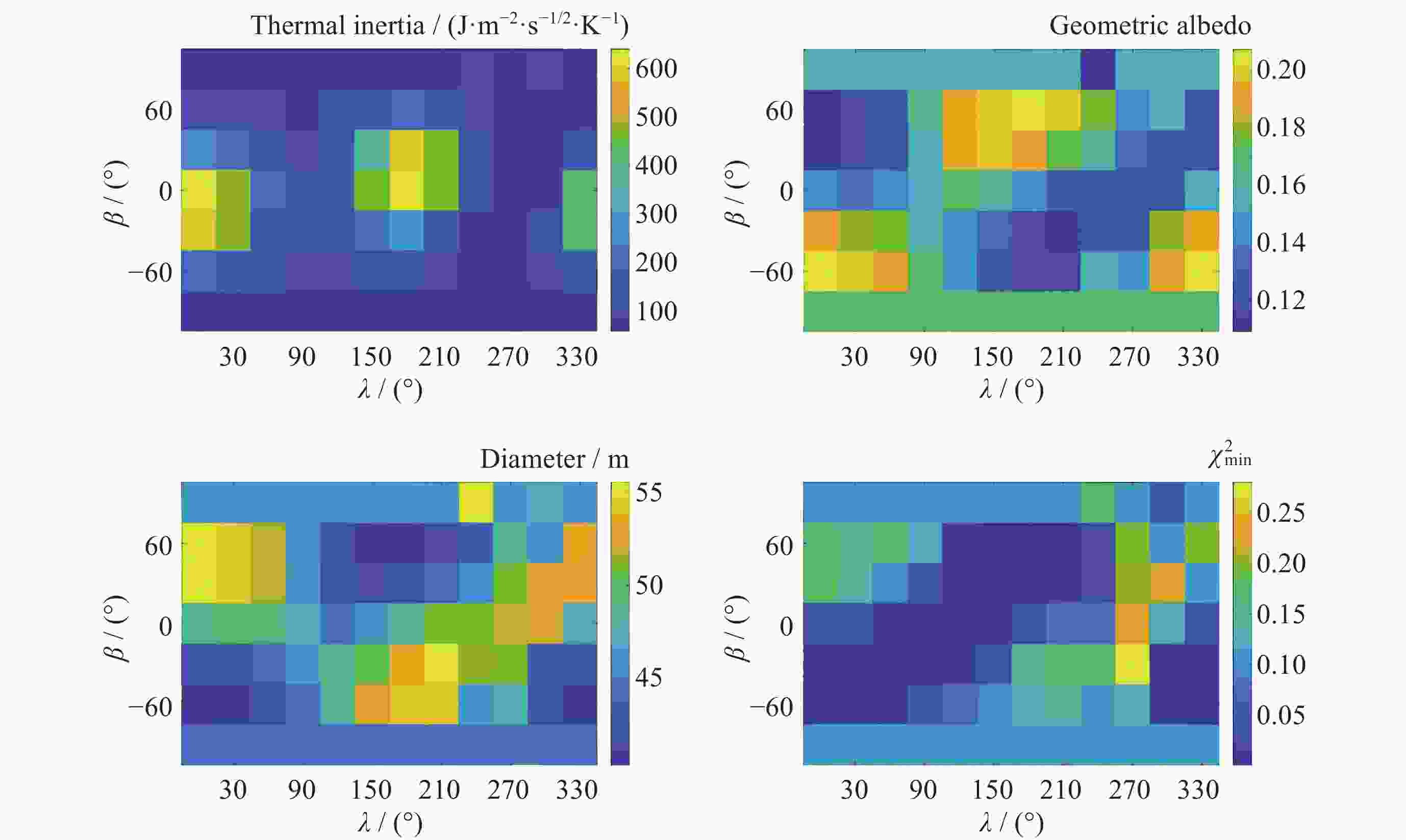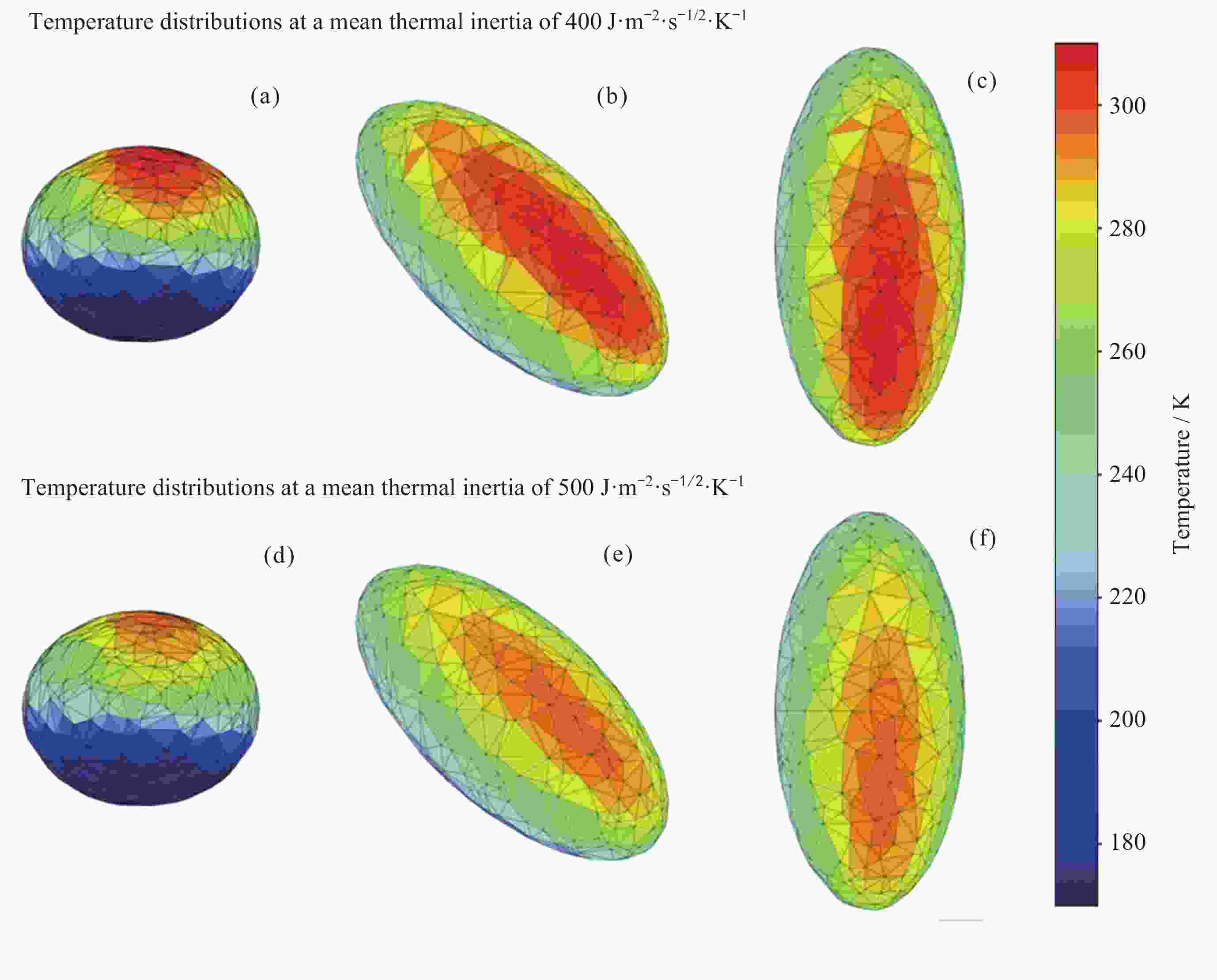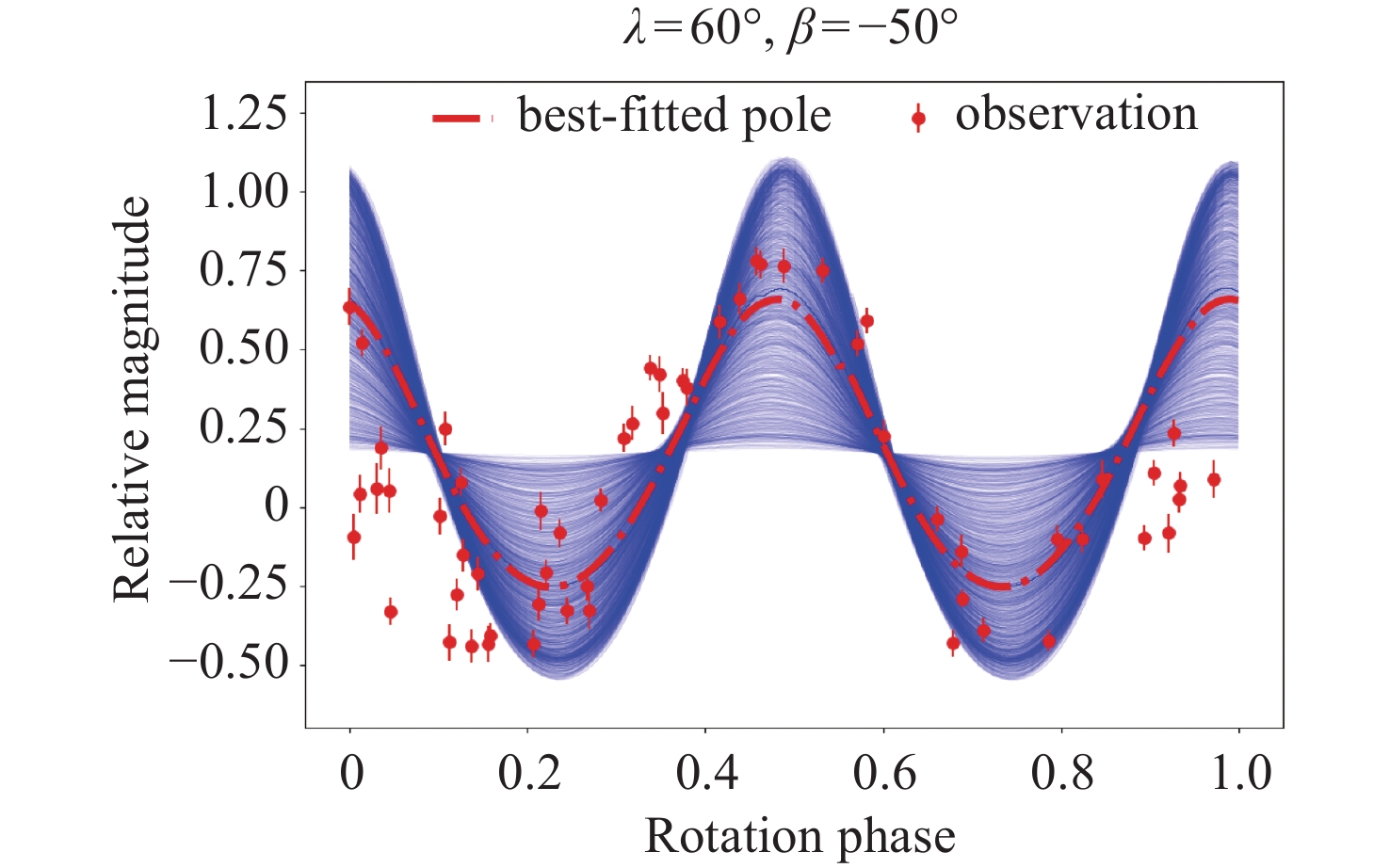天问二号任务目标小行星 (469219) Kamo‘oalewa的自转特征与表面热环境
doi: 10.11728/cjss2025.03.2025-yg04 cstr: 32142.14.cjss.2025-yg04
Rotational Characteristics and Surface Thermal Environment of Asteroid (469219) Kamo‘oalewa: Target of the Tianwen-2 Mission
-
摘要: 详细分析了近地小行星Kamo‘oalewa的轨道特征、自转参数以及与地球的相对运动, 通过对光变曲线的拟合, 初步确定了该小行星自转轴的指向 ($ \lambda =67. 9°\pm {3. 1}^{\circ },\;\beta =-46. 0°\pm {10. 6}^{\circ } $). 模拟未来天问二号空间任务对该小行星的探测过程, 得到了探测器在接近小行星过程中可能观测到的视星等级的变化情况. 利用先进热物理模型 (ATPM), 对Kamo‘oalewa的表面温度分布进行详细分析, 揭示该小行星在不同热惯量条件下的详细温度分布特征. 基于分析对未来深入研究该天体的路径进行了展望, 强调高分辨率探测设备及长期观测数据对提高小行星旋转特性和轨道参数精度的重要意义. 天问二号任务的顺利实施将为进一步揭示小行星的起源与演化历史提供宝贵的数据支撑.
-
关键词:
- 近地小行星 /
- 469219 Kamo‘oalewa (2016 HO3) /
- 自转参数 /
- 数据分析
Abstract: This paper provides a comprehensive analysis of the orbital characteristics, rotation parameters, and relative motion with Earth of the near-Earth asteroid 2016 HO3 (Kamo‘oalewa). Through fitting the asteroid observed light curve, we preliminarily determined the orientation of its rotation axis as $ \lambda =67. 9°\pm {3. 1}^{\circ },\;\beta =-46. 0°\pm {10. 6}^{\circ } $. By simulating the forthcoming Tianwen-2 space mission, we predicted changes in the apparent magnitude of the asteroid as observed by the spacecraft during its approach phase. Using the Advanced Thermophysical Model (ATPM), we performed a detailed analysis of the surface temperature distribution of asteroid 2016 HO3, revealing detailed temperature distribution features under varying thermal inertia conditions. Finally, this paper outlines future research directions, highlighting the significant potential for improved accuracy in determining the asteroid rotational parameters and orbital properties through higher-resolution observations and longer-term data accumulation. The successful implementation of the Tianwen-2 mission will provide crucial data, further advancing our understanding of the origins and evolutionary histories of asteroids. -
图 9 Kamo‘oalewa不同平均热惯量的表面温度分布. (a)~(c)是平均热惯量为$ 400\text{J}\cdot {\text{m}}^{-2}\cdot {\text{s}}^{-0.\mathrm{ }\mathrm{ }\mathrm{ }\mathrm{ }\mathrm{ }\mathrm{ }5}\cdot {\text{K}}^{-1} $时的温度分布, (d)~(f)是平均热惯量为$ 500\text{J}\cdot {\text{m}}^{-2}\cdot {\text{s}}^{-0.\mathrm{ }\mathrm{ }\mathrm{ }\mathrm{ }\mathrm{ }\mathrm{ }5}\cdot {\text{K}}^{-1} $时的温度分布
Figure 9. Kamo‘oalewa Surface temperature distribution plots for different mean thermal inertia. (a)~(c) are the temperature distributions at a mean thermal inertia of $ 400\text{J}\cdot {\text{m}}^{-2}\cdot {\text{s}}^{-0.5}\cdot {\text{K}}^{-1} $, and (d)~(f) are the temperature distributions at a mean thermal inertia of $ 500\text{J}\cdot {\text{m}}^{-2}\cdot {\text{s}}^{-0.\mathrm{ }\mathrm{ }\mathrm{ }\mathrm{ }\mathrm{ }\mathrm{ }5}\cdot {\text{K}}^{-1} $
表 1 四颗小行星的热惯量估计结果
Table 1. Thermal inertia estimations for four asteroids
-
[1] THOLEN J D, RAMANJOOLOO Y, FOHRING D, et al. A potpourri of near-Earth asteroid observations[C]//American Astronomical Society, DPS Meeting. 2016 [2] DE LA FUENTE MARCOS C, DE LA FUENTE MARCOS R. Asteroid (469219) 2016 HO3, the smallest and closest earth quasi-satellite[J]. Monthly Notices of the Royal Astronomical Society, 2016, 462(4): 3441-3456 doi: 10.1093/mnras/stw1972 [3] BENFORD J. Looking for lurkers: Co-orbiters as SETI observables[J]. The Astronomical Journal, 2019, 158(4): 150 doi: 10.3847/1538-3881/ab3e35 [4] FENUCCI M, NOVAKOVIĆ B. The Role of the Yarkovsky Effect in the long-term dynamics of Asteroid (469219) Kamo‘oalewa[J]. The Astronomical Journal, 2021, 162(6): 227 doi: 10.3847/1538-3881/ac2902 [5] HU S C, LI B, JIANG H X, et al. Peculiar orbital Characteristics of Earth Quasi-Satellite 469219 Kamo‘oalewa: Implications for the yarkovsky detection and orbital uncertainty propagation[J]. The Astronomical Journal, 2023, 166(4): 178 doi: 10.3847/1538-3881/acf8cc [6] SHARKEY B N L, REDDY V, MALHOTRA R, et al. Lunar-like silicate material forms the Earth quasi-satellite (469219) 2016 HO3 Kamoʻoalewa[J]. Communications Earth :Times New Roman;">& Environment, 2021, 2(1): 231 [7] WINTER O, MOTAES R, GOMES L, et al. On the possibility that 2016 HO3 Kamo‘oalewa was a piece of the Moon[C]//44th COSPAR Scientific Assembly. 2022, 44: 274 [8] ZHANG P F, LI Y, ZHANG G Z, et al. (469219) Kamo'OALEWA, a Space-Weathering-Matured LL-Chondrite-Like Small NEA: Target of the Tianwen-2 Sample Return Mission[C]//Europlanet Science Congress 2024. Berlin: Freie Universität, 2024 [9] JIAO Y F, CHENG B, HUANG Y K, et al. Asteroid Kamo‘oalewa’s journey from the lunar Giordano Bruno crater to Earth 1: 1 resonance[J]. Nature Astronomy, 2024, 8(7): 819-826 doi: 10.1038/s41550-024-02258-z [10] HEILIGERS J, FERNANDEZ J M, STOHLMAN O R, et al. Trajectory design for a solar-sail mission to asteroid 2016 HO3[J]. Astrodynamics, 2019, 3(3): 231-246 doi: 10.1007/s42064-019-0061-1 [11] VENIGALLA C, BARESI N, AZIZ J D, et al. Near-Earth Asteroid Characterization and Observation (NEACO) mission to asteroid (469219) 2016 HO3[J]. Journal of Spacecraft and Rockets, 2019, 56(4): 1121-1136 doi: 10.2514/1.A34268 [12] CHI Z M, LI H Y, JIANG F H, et al. Power-limited low-thrust trajectory optimization with operation point detection[J]. Astrophysics and Space Science, 2018, 363(6): 112 doi: 10.1007/s10509-018-3336-8 [13] HUANG J C, ZHANG X J, WANG T, et al. Small body exploration in China[C]//14th Europlanet Science Congress. 2020 (https://meetingorganizer.copernicus.org/EPSC2020/EPSC2020-1126.html) [14] ZHANG T, WANG B, WEI H Y, et al. Review on planetary regolith-sampling technology[J]. Progress in Aerospace Sciences, 2021, 127: 100760 doi: 10.1016/j.paerosci.2021.100760 [15] ZHANG T, XU K, DING X L. China’s ambitions and challenges for asteroid-comet exploration[J]. Nature Astronomy, 2021, 5(8): 730-731 doi: 10.1038/s41550-021-01418-9 [16] HUANG J C, JI J H, YE P J, et al. The Ginger-shaped Asteroid 4179 Toutatis: new Observations from a Successful Flyby of Chang’E-2[J]. Scientific Reports, 2013, 3(1): 3411 doi: 10.1038/srep03411 [17] LI Y, ZHAO Y H. The Toutatis (4179) boulders: shallow slope in size distribution and shape statistics[J]. Solar System Research, 2023, 57(5): 495-504 doi: 10.1134/S0038094623050088 [18] ZHAO Y, JI J. Study on rotational parameters for asteroid 4179 Toutatis from chang’E-2’s close flyby[C]//Serendipities in the Solar System and Beyond. Taiwan, China: National Central University, 2018, 513: 111 [19] HU S C, JI J H, RICHARDSON D C, et al. The formation mechanism of 4179 Toutatis' elongated bilobed structure in a close Earth encounter scenario[J]. Monthly Notices of the Royal Astronomical Society, 2018, 478(1): 501-515 doi: 10.1093/mnras/sty1073 [20] JIANG Y, JI J H, HUANG J C, et al. The distribution and source of boulders on asteroid 4179 Toutatis[J]. Proceedings of the International Astronomical Union, 2015, 10(S318): 153-155 doi: 10.1017/S1743921315007280 [21] JI J H, JIANG Y, ZHAO Y H, et al. Chang’E-2 spacecraft observations of asteroid 4179 Toutatis[J]. Proceedings of the International Astronomical Union, 2015, 10(S318): 144-152 doi: 10.1017/S1743921315008674 [22] JI J H, JIANG Y, ZHAO Y H. New observations of asteroid (4179) Toutatis as closely observed by Chang’E-2[J]. IAU General Assembly, 2015, 29: 2256604 [23] ZHAO Y H, JI J H, HUANG J C, et al. Orientation and rotational parameters of asteroid 4179 Toutatis: new insights from Chang’E-2’s close flyby[J]. Monthly Notices of the Royal Astronomical Society, 2015, 450(4): 3620-3632 doi: 10.1093/mnras/stv792 [24] BARUCCI M A, FULCHIGNONI M, JI J H, et al. The Flybys of Asteroids (2867) Šteins, (21) Lutetia, and (4179) Toutatis[M]//MICHEL P, DEMEO F E. BOTTKE W F. Asteroids IV. Tucson: University of Arizona Press, 2015: 433-450 [25] ZHANG Y X, GUO W X, ZHENG H, et al. DCAPPSO: A novel approach for inverting asteroid rotational properties with applications to DAMIT and Tianwen-2 target asteroid[J]. Astronomy and Computing, 2025, 51: 100925 doi: 10.1016/j.ascom.2024.100925 [26] LI X Y, SCHEERES D J. The shape and surface environment of 2016 HO3[J]. Icarus, 2021, 357: 114249 doi: 10.1016/j.icarus.2020.114249 [27] VOKROUHLICKÝ D. Diurnal Yarkovsky effect as a source of mobility of meter-sized asteroidal fragments. I. Linear theory[J]. Astronomy and Astrophysics, 1998, 335: 1093-1100 [28] LIU L, CHEN Q, YAN J G, et al. Surface thermal inertia of near-earth asteroid (469219) kamo`oalewa: Statistical estimation and implications[J]. Solar System Research, 2024, 58(4): 469-479 doi: 10.1134/S0038094624700321 [29] FENUCCI M, NOVAKOVIĆ B, ZHANG P F, et al. Astrometry, orbit determination, and thermal inertia of the Tianwen-2 target asteroid (469219) Kamo ‘oalewa[J]. Astronomy :Times New Roman;">& Astrophysics, 2025, 695: A196 [30] JI J H, TAN D J, BAO C H, et al. PyMsOfa: A python package for the Standards of Fundamental Astronomy (SOFA) service[J]. Research in Astronomy and Astrophysics, 2023, 23(12): 125015 doi: 10.1088/1674-4527/ad0499 [31] MŰLLER M. Surface Properties of Asteroids from Mid-Infrared Observations and Thermophysical Modeling[D]. Berlin: Free University of Berlin, 2007 [32] SHIMAKI Y, SENSHU H, SAKATANI N, et al. Thermophysical properties of the surface of asteroid 162173 Ryugu: Infrared observations and thermal inertia mapping[J]. Icarus, 2020, 348: 113835 doi: 10.1016/j.icarus.2020.113835 [33] DELLAGIUSTINA D N, EMERY J P, GOLISH D R, et al. Properties of rubble-pile asteroid (101955) Bennu from OSIRIS-REx imaging and thermal analysis[J]. Nature Astronomy, 2019, 3(4): 341-351 doi: 10.1038/s41550-019-0731-1 [34] DELBO M, MUELLER M, EMERY J P, et al. Asteroid Thermophysical Modeling[M]//MICHEL P, DEMEO F E. BOTTKE W F. Asteroids IV. Tucson: University of Arizona Press, 2015, 1: 107-128 [35] HANUŠ J, DELBO M, ĎURECH J, et al. Thermophysical modeling of main-belt asteroids from WISE thermal data[J]. Icarus, 2018, 309: 297-337 doi: 10.1016/j.icarus.2018.03.016 [36] ROZITIS B, GREEN S F, MACLENNAN E, et al. Observing the variation of asteroid thermal inertia with heliocentric distance[J]. Monthly Notices of the Royal Astronomical Society, 2018, 477(2): 1782-1802 doi: 10.1093/mnras/sty640 [37] HUNG D, HANUŠ J, MASIERO J R, et al. Thermal properties of 1847 WISE-observed asteroids[J]. The Planetary Science Journal, 2022, 3(3): 56 doi: 10.3847/PSJ/ac4d1f [38] FENUCCI M, NOVAKOVIĆ B, VOKROUHLICKÝ D, et al. Low thermal conductivity of the superfast rotator (499998) 2011 PT[J]. Astronomy :Times New Roman;">& Astrophysics, 2021, 647: A61 [39] FENUCCI M, NOVAKOVIĆ B, MARČETA D. The low surface thermal inertia of the rapidly rotating near-Earth asteroid 2016 GE1[J]. Astronomy :Times New Roman;">& Astrophysics, 2023, 675: A134 [40] 余亮亮, 季江徽, 王素. 近地小行星(162173)1999JU3的热惯量和表面特征研究[J]. 天文学报, 2013, 54(6): 537-549 doi: 10.3969/j.issn.0001-5245.2013.06.004YU Liangliang, JI Jianghui, WANG Su. Investigation of thermal inertia and surface properties for near-Earth Asteroid (162173) 1999 JU3[J]. ActaAstronomica Sinica, 2013, 54(6): 537-549 doi: 10.3969/j.issn.0001-5245.2013.06.004 [41] JIANG H X, JI J H. Thermophysical modeling of 20 Themis Family Asteroids with WISE/NEOWISE Observations[J]. The Astronomical Journal, 2021, 162(2): 40 doi: 10.3847/1538-3881/ac01c8 [42] JIANG H X, JI J H, YU L L. Determination of size, albedo, and thermal inertia of 10 Vesta Family Asteroids with WISE/NEOWISE observations[J]. The Astronomical Journal, 2020, 159(6): 264 doi: 10.3847/1538-3881/ab8af5 [43] JIANG H X, JI J H, YU L L, et al. Mid-IR observations of IRAS, AKARI, WISE/NEOWISE, and subaru for large icy asteroid (704) Interamnia: a new perspective of regolith properties and water ice fraction[J]. The Astrophysical Journal, 2023, 944(2): 202 doi: 10.3847/1538-4357/acaeaa [44] JIANG H X, YU L L, JI J H. Revisiting the advanced thermal physical model: New perspectives on thermophysical characteristics of (341843) 2008 EV5 from Four-band WISE Data with the Sunlight-reflection model[J]. The Astronomical Journal, 2019, 158(5): 205 doi: 10.3847/1538-3881/ab46b4 [45] YU L L, YANG B, JI J H, et al. Thermophysical characteristics of the large main-belt asteroid (349) Dembowska[J]. Monthly Notices of the Royal Astronomical Society, 2017, 472(2): 2388-2397 doi: 10.1093/mnras/stx2089 [46] YU L L, JI J H, IP W H. Surface thermophysical properties on the potentially hazardous asteroid (99942) Apophis[J]. Research in Astronomy and Astrophysics, 2017, 17(7): 070 doi: 10.1088/1674-4527/17/7/70 [47] YU L L, JI J H. Surface thermophysical properties determination of OSIRIS-REx target asteroid (101955) Bennu[J]. Monthly Notices of the Royal Astronomical Society, 2015, 452(1): 368-375 doi: 10.1093/mnras/stv1270 [48] NOVAKOVIĆ B, FENUCCI M, MARČETA D, et al. ASTERIA—Asteroid thermal inertia analyzer[J]. The Planetary Science Journal, 2024, 5(1): 11 doi: 10.3847/PSJ/ad08c0 [49] REN J L, WU B, HESSE M A, et al. Surface dynamics of small fast-rotating asteroids: analysis of possible regolith on asteroid 2016 HO3[J]. Astronomy :Times New Roman;">& Astrophysics, 2024, 692: A62 [50] 李春来, 刘建军, 任鑫, 等. “天问二号”任务科学目标和有效载荷配置[J]. 深空探测学报(中英文), 2024, 11(3): 304-310 doi: 10.15982/j.issn.2096-9287.2024.20230185LI Chunlai, LIU Jianjun, REN Xin, et al. Scientific objectives and payloads configuration of the Tianwen-2 Mission[J]. Journal of Deep Space Exploration, 2024, 11(3): 304-310 doi: 10.15982/j.issn.2096-9287.2024.20230185 -
-





 应佳峻 男, 1999年11月出生于江苏省苏州市, 现为中国科学技术大学天文与空间科学学院(紫金山天文台)在读博士研究生. 主要研究方向为太阳系小天体物理特性研究. E-mail:
应佳峻 男, 1999年11月出生于江苏省苏州市, 现为中国科学技术大学天文与空间科学学院(紫金山天文台)在读博士研究生. 主要研究方向为太阳系小天体物理特性研究. E-mail: 

 下载:
下载:
